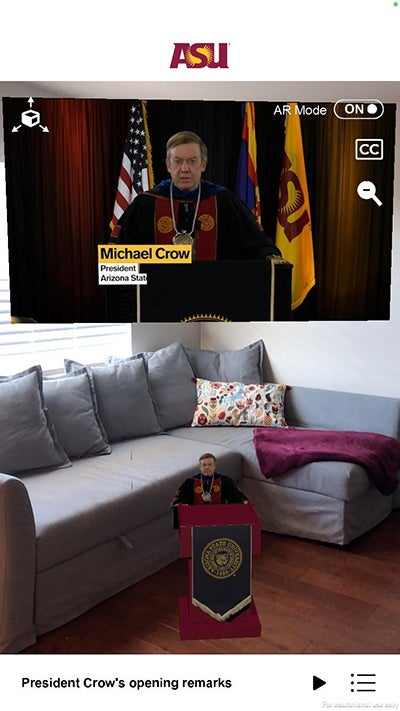In an effort to provide fall 2020 graduates the best virtual ceremony innovation can create, a team of a dozen students from ASU’s Meteor Studio, in coordination with the XR at ASU initiative, created a new way to bring graduation into living rooms around the world with a complete augmented reality experience.
The ASU Commencement app leverages augmented reality technologies to display the virtual ceremony on the viewer’s phone or tablet, using the device’s camera to capture their surroundings as the backdrop and seemingly bring graduation right into their living spaces. Using the app, graduates can virtually stand on stage with President Michael M. Crow during his commencement address, join Provost Mark Searle on the 50-yard line at Sun Devil Football Stadium, sing the university’s alma mater alongside the ASU Chamber Singers and more.
“The ASU Commencement app offers a new way for our entire Sun Devil community — including students, families, faculty and staff — to experience the fall 2020 graduation ceremony,” said Robert LiKamWa, director of ASU Meteor Studio and an assistant professor. “Built by students, for students, the team leveraged emerging technologies to bring graduation into the homes of graduates everywhere to offer a more interactive experience for their peers to celebrate this academic milestone.”
Starting on Dec. 14 at 9 a.m. Arizona time, graduates were able to stream the university ceremony directly through the app, inviting Crow and other campus leadership into their living rooms. The 35-minute experience also featured a special look back over the past four years, a performance of the ASU alma mater and closing celebratory activities. The app is in addition to the official stream of the virtual fall 2020 Commencement and Convocation ceremonies.
The app is accessible via any iOS or Android phone or tablet and is free to download in the App Store and Google Play. There is no sign-up needed to access the experience.

An example of the view inside the app.
Built by students, for students — from design to development
In anticipation of a virtual fall 2020 ceremony, a team of 12 students got to work this semester to design a more immersive experience for upcoming graduates and their families to celebrate and participate in the ceremony.
Students Aashiq Shaikh, Lauren Gold, Alireza Bahremand, Linda Nguyen, Matthew Soson, Xavier McDonald, Tracey Lott, Luis Espinoza, Taetum Knebel, Jonathan Peterson and Desarael Black, along with visiting artist William Ayton, led the project from design to development.
“As a team of graduate students, we knew firsthand the importance for upcoming graduates to be able to celebrate this milestone in their academic journey,” said Shaikh, a PhD candidate and part of the development team for the ASU Commencement app. “Since we couldn’t bring students to graduation, we decided to bring graduation to the students, regardless of where they were. So for the past four months, we’ve been creating an augmented reality experience to accomplish this goal.”
The ASU Commencement app was built in Unity’s Game Engine, with Google ARCore and Apple ARKit technologies. The experience incorporates some of ASU’s most notable locations, including flyover footage of the Tempe campus, as well as 360-degree footage of Sun Devil Stadium, shot by the team. Students partnered with the Enterprise Marketing Hub to capture the commencement ceremony address made by university leaders.
Innovation that lasts
ASU is proud to present its first AR graduation experience. Looking ahead, students from the Meteor Studio noted that they will continue to work on developing the app over the next few months and anticipate the AR experience will be part of graduations for years to come.
Congrats to all fall 2020 Sun Devil graduates!
Top photo: ASU graduate students Aashiq Shaikh (left) and Alireza Bahremand capture President Michael M. Crow recording his university commencement address. Photo by Matthew Soson
More Science and technology

Lucy's lasting legacy: Donald Johanson reflects on the discovery of a lifetime
Fifty years ago, in the dusty hills of Hadar, Ethiopia, a young paleoanthropologist, Donald Johanson, discovered what would become one of the most famous fossil skeletons of our lifetime — the 3.2…

ASU and Deca Technologies selected to lead $100M SHIELD USA project to strengthen U.S. semiconductor packaging capabilities
The National Institute of Standards and Technology — part of the U.S. Department of Commerce — announced today that it plans to award as much as $100 million to Arizona State University and Deca…

From food crops to cancer clinics: Lessons in extermination resistance
Just as crop-devouring insects evolve to resist pesticides, cancer cells can increase their lethality by developing resistance to treatment. In fact, most deaths from cancer are caused by the…
